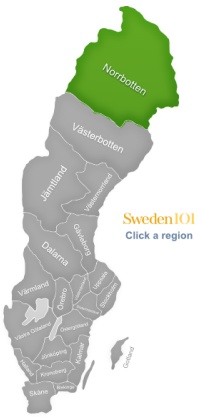Norrbotten - Norrbotten archipelago, Luleå, Gammelstad Church Town
0 Norrbotten Diaspora around the world
Our in-person family gatherings
Ireland's President Higgins family message
Our TEDx talk about family gatherings

What does the name of the region mean?
Norrbotten is translated as North Bothnia, and is the most northerly region of Sweden.
What is the region's historical importance?
Historically speaking, there aren't many records about Norrbotten until the later middle ages, because the region was rather uninhabited. There were Sami people, who were hunters, fishermen and reindeer herders, but it took a while until the region became more “civilized”. In the late 15th century, and then in the 16th century, the region had a better connection to Sweden (though the Finnish also had quite an influence on the region), and a stone church was built. The Swedish kings tried hard to Christianize the region, but did not only make friends with that.
What is the region known for?
The region covers one fourth of the total land mass of Sweden, but is one of the least populated region (when you look at the number of people per square kilometer). This is not much of a surprise as the weather up in the Arctic circle can be very harsh, and people are generally not drawn to this type of climate.
It was the last region of Sweden to be officially recognized as a province of Sweden – it only happened in 1995, after decades (!!) of arguing about it. The people who live in the region are also often not so eager to call themselves Swedish, and often prefer to call themselves Norrbottians or something along those lines. You will often also hear other dialects or even other languages being spoken, e.g. Sami or Finnish, as there are Sami and Finnish people in the region.
What are some places you need to visit in Norrbotten?
While Norrbotten is quite a beautiful region (but cold), it doesn't draw that many visitors, but there are some places worth a visit. One positive thing is that you won't have to deal with other tourists. You might not meet a single one, depending on when and where you go.
Gammelstad Church Town
This little town has made it on the UNESCO World Heritage list. There are well over 400 wooden buildings, and one church from the 15th century. In the past, little villages like this used to be quite common in Scandinavian regions. The church town was basically meant for people who wanted to visit church on Sunday, or who would like to take part in some of the religious festivals, but who could not travel home on the same day. So the houses were usually only used on Sundays or during festivals.
Luleå
Luleå is the capital of Norrbotten, and home to a bit under 47,000 people. The town was originally seated where the Gammelstad Church town sits today, but at some stage the town had to be moved because the water in the bay was becoming too shallow for ships to enter, and as the town depended on the ships for trading, they had to move. A Neo-Gothic Cathedral is the highest building in town (67 metres) and was erected in the late 19th century. Luleå was destroyed by a serious fire in 1887, so you will not find many historical buildings in this town at all.
Norrbotten archipelago
In summer, the islands of the Norrbotten archipelago are popular with local and international visitors, but only few of the islands actually have permanent inhabitants. In winter, many of the islands become icebound, and the water is often frozen until April each year. During summer, you have daylight for 24 hours, and in winter, there is a full moon all day long.

_(2).jpg)